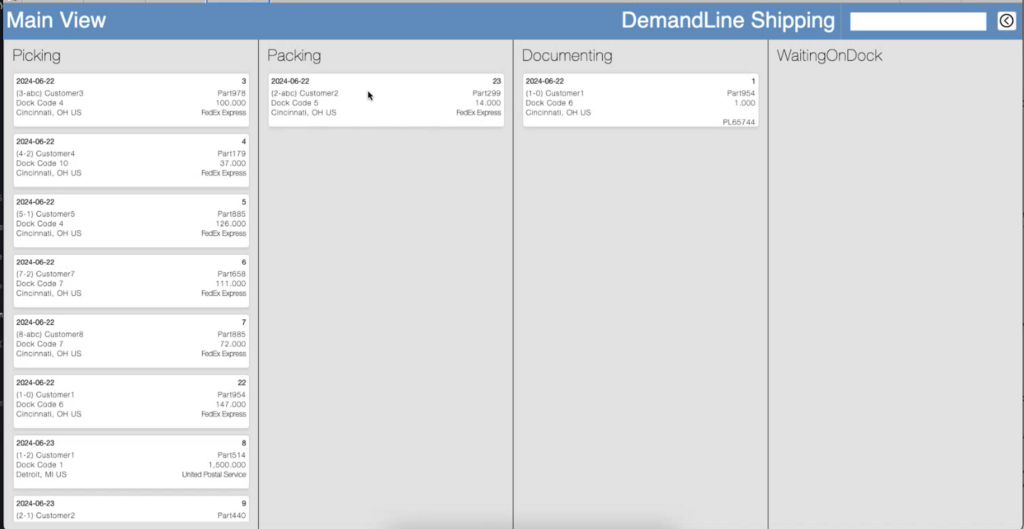By: Emmeram Morning, CEO, Robot Morning
The aerospace supply chain is in digital transformation. In this blog, we focus on the impact digital transformation is having on the shipping process that suppliers must execute to fulfill customer orders. While the direct labor savings are 50% or greater, the indirect impact of timely, accurate delivery on customer satisfaction and time to revenue could be more than double that. Let's take a look at recommendations for automating the shipping process, and what results suppliers should expect.
Target for Automation: Shipping Process
The shipping process we're focused on is what a shipping coordinator does to get a customer's order to the shipping carrier. It can be broken down into these steps:
- Picking: A shipping coordinator receives a list of products that need to be shipped to the customer. The shipping coordinator must find and retrieve these items from the inventory, do required quality inspections, and meet shipment due dates.
- Packing: Putting the order into the required shipping containers or boxes.
- Documenting: Creating the proper documentation and data required for validation of the shipment.
- Waiting on Dock: Create the Bill of Lading and deliver it to the dock for carrier pickup.
Digital Transformation: Automating the Shipping Process
The digitalized shipping process should keep all data accurate and up to date, and all activities aligned and efficient – while making it simple and effortless for the person responsible. A process-oriented workflow should be available wherever the work is being done to direct and streamline the physical labor required. Workflows and screens should be personalized to the role and individual doing the work.

If we follow the shipping process from start to finish, we start with the picking list itself. If the list is digitally connected to the system of record (the ERP), then this list is always up to date and prioritized for the shipping coordinator in real time. The list must be ordered according to shippable date, current inventory, and shipping priority among customers and locations.
The shipping traveler with appropriate barcode and required shipping information is immediately available for the next order in the prioritized sequence. A barcode scanner will keep track of this order during the process. As the picking process progresses, the shipping coordinator simply scans bar codes for each completion, which updates the list and status in real time.
For the packing process, the correct labels are immediately available. The shipping coordinator inputs a few pieces of data at the point of packing, including physical shipping information, count/dimension of boxes and weights, etc. If there is any information required by the customer, such as a quality authorization number, carrier, tracking number, and PTA code, the system prompts the coordinator.
In the documenting stage, the packing slip is automatically produced to send with the shipment. ASNs should be automated between the supplier and the customer, eliminating the need for the shipping coordinator to go into a customer portal.
All shipments for each carrier are ready for pick up, after which the ERP is automatically updated with the status.
Shipping Managers or front-office employees see everything that is happening in the shipping process at any time.
Digital Transformation Results
The shipping process is simply part of the larger digital thread that we build for the aerospace supply chain. Using Robot Morning's DemandLine, the supplier's ERP is connected to the customer's ERP through AXON, our fully automated, secure, always-on network that is the nerve center of the intelligent supply chain.
Using the Shipping functionality in DemandLine, the shipping process is integrated with the digital thread from supplier to customer. Picking lists are prioritized and updated in real time, with a digital workflow showing the exact status of each phase of the shipping process.
There are both direct and indirect impacts for the supplier:
- 50%+ Reduction in Cost of Labor. There is about a 20% reduction in time required for the shipping process, so fewer employees are required. At the same time, shipping coordinators no longer have to access the ERP and manually update data. That type of work requires a highly trained resource. With automation, the skill level of the worker is much lower, and thus the cost of each employee goes down by about 40%.
- Reduction in Manual Data Entry Errors and Associated Costs. The ERP no longer needs to be touched by a human, but is automatically updated with correct, real-time status simply through automated processes and bar codes. Companies using manual processes try to reduce the cost of mistakes by having better SOPs, better training, audit trails, and/or more floor managers. That need is virtually eliminated.
- Customer Satisfaction and Time to Revenue. Using digitalized shipping, mistakes and missed deadlines are greatly reduced, with the system constantly prioritizing the picking list based on shippable dates, inventory levels and customer priority. Suppliers can get orders to customers more quickly, reducing the time to revenue. The shipping process can continue to be leaned using profiling data produced by the system to benchmark efficiency and identify bottlenecks.
Take the next step in automating your shipping process. Check out our DemandLine Savings Calculator to see how DemandLine enables a no-touch, fully-automated, fully-digital connection between your customers’ systems of record and your own.
